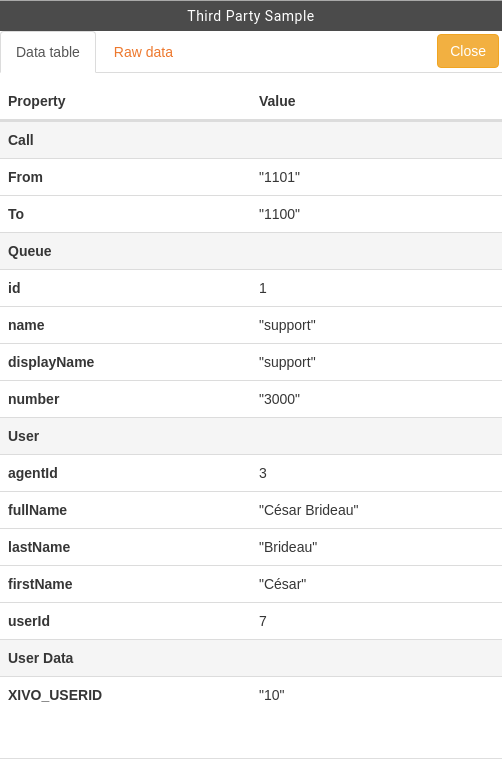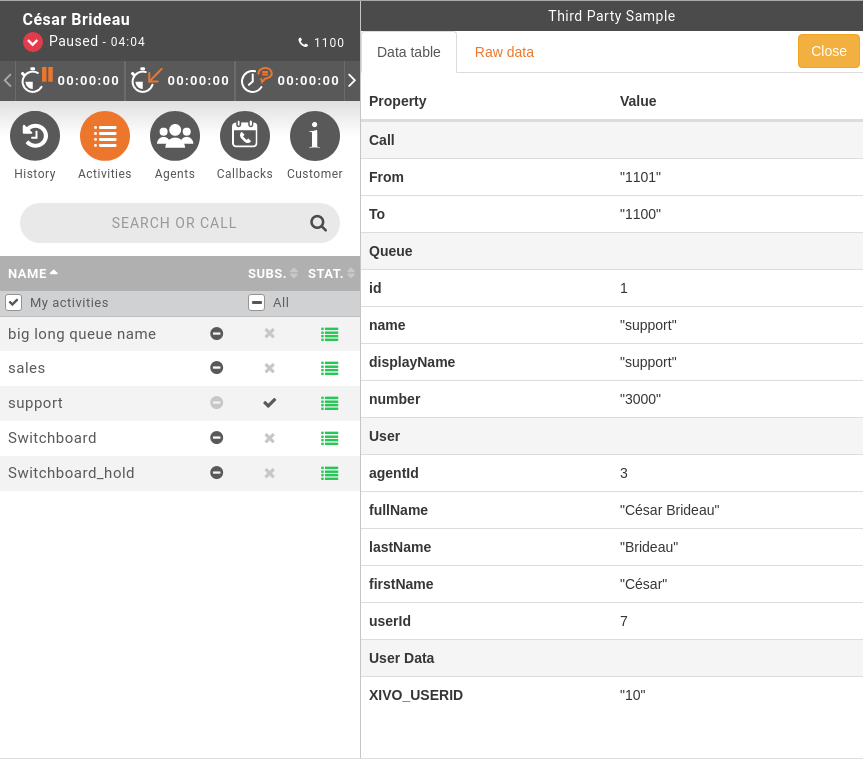Third Party Integration
Third party web application integration is possible inside the XucMgt Agent application. Upon each call, you can display a custom panel next to the agent interface:

Workflow
When a call is ringing on the agent phone, the Application will call the external web service (see Configuration below). The web service response will dictate the behaviour of the integration. For example, if the speficied action is to open the application when the call is hung up, a new panel will be created and opened inside the agent interface, showing the content specified by the web service response. (see Web Service API for available options).
When the work is complete in the integrated application, the application must post a message to terminate the third party application pane inside the agent application (see Completion).

Configuration
You need to specify the third party application web service url to integrate this application inside the XucMgt Agent interface. This can be done by giving a value to the THIRD_PARTY_URL environment variable
in the /etc/docker/compose/custom.env file
...
THIRD_PARTY_URL=http://some.url.com/ws/endpoint
The speficied URL must be accessible from the client browser (i.e. the end user of the Agent application). The call wil be made from his browser.
Web Service API
The Web Service url specified in the :Configuration must conforms to the following behaviour.
The service will receive a POST request with a payload as application/json, for example:
{
"user":{
"userId":4,
"agentId":1,
"firstName":"James",
"lastName":"Bond",
"fullName":"James Bond"
},
"callee":"1000",
"caller":"1001",
"queue":{
"id":2,
"name":"trucks",
"displayName":"Trucks",
"number":"3001"
},
"userData":{
"XIVO_CONTEXT":"default",
"XIVO_USERID":"2",
"XIVO_SRCNUM":"1001",
"XIVO_DSTNUM":"3001"
}
}
usercontains the connected user informationcalleecontains the number calledqueuequeue propertiesuserDatacall data presented by Xivo
The Web service must answer with an application/json content. For example:
{
"action":"open",
"event":"EventReleased",
"url":"/thirdparty/open/6bd37819-b4a6-43d3-8fa3-6eb6489bb705",
"autopause":true,
"autopauseReason:"backoffice",
"title":"Third Party Sample"
}
or:
{
"action":"none"
}
actionis one ofopen: Will open the givenurlinside the integration panepopup: Will open the givenurlin a popuprun: Will run the givenurlas an executable, only works in desktop assistant.none: No action will be performed
eventis one ofEventRinging,EventEstablished,EventReleased. The third party application will be opened when one the specified event occursurlshould be the url to open inside the application. This url should point to a valid web application that can be specific for each call.executableArgscan contain an array of argument for therunaction.autopauseif set to true, the agent will be put on pause when the application pane is opened and back to ready when the application is completed.autopauseReasonan optional field allowing to set the type of the pause used while setting the agent on pause (see the line above).multitabif set to true andactionis set topopup, then the integration will be opened a in new popup window (or tab) each time instead of reusing the same window (or tab).titlewill set the title of the tabs that will be opened.
Warning, when the XucMgt application and the integrated application are on different server, domain, url,… (which should be common case), You may get CORS errors. To workaround this issue, you should implement the OPTIONS request on your web service. This method will be called by the browser before issuing the POST request to ensure the target web server allows calls from the original application. You application must set at least the following headers in order to overcome the CORS errors:
Access-Control-Allow-Origin: * or the domain hosting the XucMgt applicationAccess-Control-Allow-Methods: POST, OPTIONS (at least)Access-Control-Allow-Headers: Origin, X-Requested-With, Content-Type, Accept (at least)
Completion
Once the work is complete inside the third party application, it should post a completion message (closeThirdParty) to the application using the Web Messaging API.
For example, here is how to define a close method in javascript to send the message to the hosting application and bind it to a simple button:
(function () {
function close() {
parent.window.postMessage("closeThirdParty", "*");
}
document.getElementById("close").addEventListener("click", close, false);
})();
Third Party Login URL Integration
To know on which XiVO a user is logged, you can configure a URL with some information about the user when they log in the application.
Configuration
You need to specify the third party application web service url to integrate this application inside the XucMgt Assistant and Agent interfaces.
This can be done by giving a value to the THIRD_PARTY_LOGIN_URL environment variable in the /etc/docker/compose/custom.env file
...
THIRD_PARTY_LOGIN_URL=https://some.url.com/logininfo?login=%{login}&token=%{token}&xivoccHost=%{xivocchost}
The service will receive the url containing the username, token and XiVOCC host of the user who just logged in.